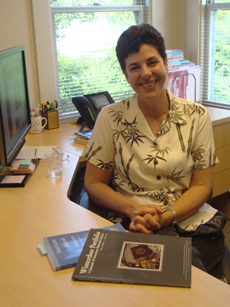
Andrea Pappas wins NEH fellowship to help uncover an important part of American history
 Enabled by a National Endowment for the Humanities (NEH) fellowship, associate professor of art history Andrea Pappas will travel this Fall to Delaware’s Winterthur Museum, Garden, and Library — the premier museum of American decorative arts whose collection includes nearly 90,000 objects made or used in America between about 1640 and 1860. Starting mid-August, the four-month fellowship will give her sustained access to embroidered landscapes produced by elite women in colonial New England. Drawing on source material as diverse as agricultural legislation and almanacs, etiquette manuals, diaries and letters, print culture, ceramics, and embroidery, she hopes to capture an important part of American History, women’s history and the history of visual arts in America. Her research is part of Embroidering the Landscape, a book whose initial chapters garnered the NEH’s interest in supporting the project through its prestigious fellowship.
Enabled by a National Endowment for the Humanities (NEH) fellowship, associate professor of art history Andrea Pappas will travel this Fall to Delaware’s Winterthur Museum, Garden, and Library — the premier museum of American decorative arts whose collection includes nearly 90,000 objects made or used in America between about 1640 and 1860. Starting mid-August, the four-month fellowship will give her sustained access to embroidered landscapes produced by elite women in colonial New England. Drawing on source material as diverse as agricultural legislation and almanacs, etiquette manuals, diaries and letters, print culture, ceramics, and embroidery, she hopes to capture an important part of American History, women’s history and the history of visual arts in America. Her research is part of Embroidering the Landscape, a book whose initial chapters garnered the NEH’s interest in supporting the project through its prestigious fellowship.
Embroidery instruction formed the core of American women’s education from the beginning of the colonial period through the 1840s. Producing a large, embroidered picture displayed a woman’s skill, refinement, and class position. Often engaging the surrounding landscapes, the needlework pieces gave women an avenue by which they could express fantasies of power; comment on pressing issues and debates of the day; and even, sometimes, subtly critique patriarchal structures and customs circumscribing their lives. “Until now, no one had unpacked the symbolism or written about these objects from this point of view because needlework generally was considered merely as part of the history of women’s education. But, the more I looked at these landscapes, the more I became intrigued, so I started to do some research on the many symbols women depicted. Next thing I knew, I had written a chapter and outlined the others,” says Pappas, who recruited Samantha Nelson '15 as her research assistant. “This experience has been very exciting for both of us. Sam made a huge difference in the amount of work I have been able to do. I am grateful to her and to the University’s Faculty-Student Research Assistant Program for allowing us to collaborate on this project.”
When asked how this book and experience will influence her teaching at Santa Clara, Pappas’ response is quick and enthusiastic: “The impact will be huge. I’ll be able to use this book in my American Women in the Visual Arts course; it’s also making me rethink my Cultures and Ideas courses; it is certainly changing the way I view 18th and 19th American art history. I am already looking forward to sharing some of my research with my students as soon as I return. This is exciting!” she concludes.